Played on Xbox Series S
The Sony Japan Studio team has been the purveyor of the most unusual and strange games for the PlayStation for many years. From his pen came horror, adventure, platformers, and projects that are even difficult to attribute to any genre, for example, Tokyo Jungle. Keiichiro Toyama, who served as director of the Siren horror trilogy and then switched to the more cheerful Gravity Rush series, also worked there. But above all, he is known as the creator of the very first Silent Hill – before collaborating with Sony, he worked for five years at Konami. In 2020, Japan Studio was abruptly shut down, and Toyama founded Bokeh Game Studio along with former colleagues from the Siren series. The first project of the newly formed team is Slitterhead, which was released not only on PlayStation 4 and PlayStation 5, but also on PC and the current Xbox.
⇡#Master at work
By creating this game, Toyama decided to return to horror, mysticism and the supernatural. We are transported to the city of Kowloon, the name of which is not just similar to the name of the former fortified city of Kowloon. The place that previously inspired writer William Gibson was, until the end of the last century, the most densely populated sewer on the planet. Lawlessness, prostitution, murders, triads, destructive fires, poverty, unsanitary conditions – a complete dystopian set. This seems like an ideal location for horror, but it’s a mixture of old Kowloon (which was demolished in 1994 and built into a tourist-attractive city) with Hong Kong – so all the houses are hung with neon signs, blinding passers-by in the evenings.
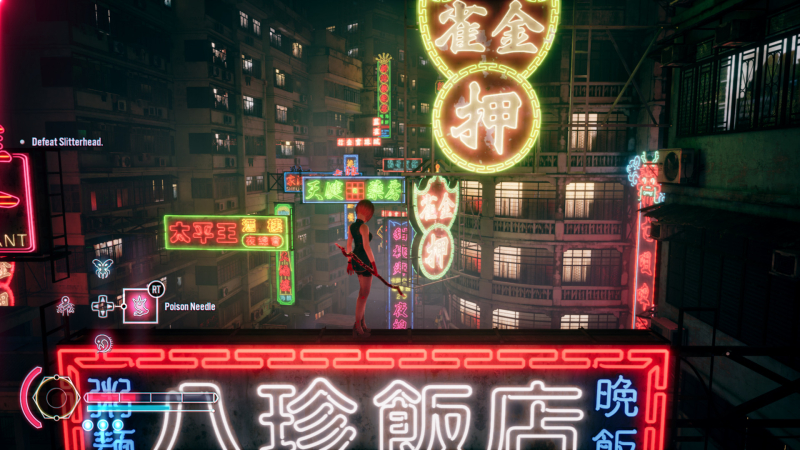
At times like these, the graphics don’t seem so outdated
Slitterhead almost never encourages you to pay attention to details, but as soon as you start slowly walking around the city, you notice the brilliant work of the designers. In houses that look more like prisons with several two-story couches in each room, everything is littered with trash, and there are plates of cold noodles on the tables. In an open-air restaurant, a cook is stirring something in a large pot, and next to it are several dirty potatoes. In grocery stores, sealed packages of bottles and products are neatly arranged on racks, with few repeats. It seems like little things, this happens in many games, but here it’s as if no one tried to stop the artists – they wanted to make Kowlong a realistic place that itself tells entire stories without unnecessary words and descriptions, and they succeeded.
We arrive in the city as Hioki, a disembodied spirit who does not remember his past, but wants to save Koulong from the so-called slitterheads. The fact is that the residents are attacked by certain creatures that suck out their brains and gain control over human bodies. Any random passer-by can be a Slitterhead – or even this guy standing on the sidewalk, drinking coffee and discussing the latest news with a colleague. At some point, the monster will want to feast on other people’s brains, and then a strange clot of blood and flesh will appear in place of the person’s head. And if this creature gets very angry, then a large monster will crawl out of its body, with a devastated, lifeless human carcass dangling behind its back.
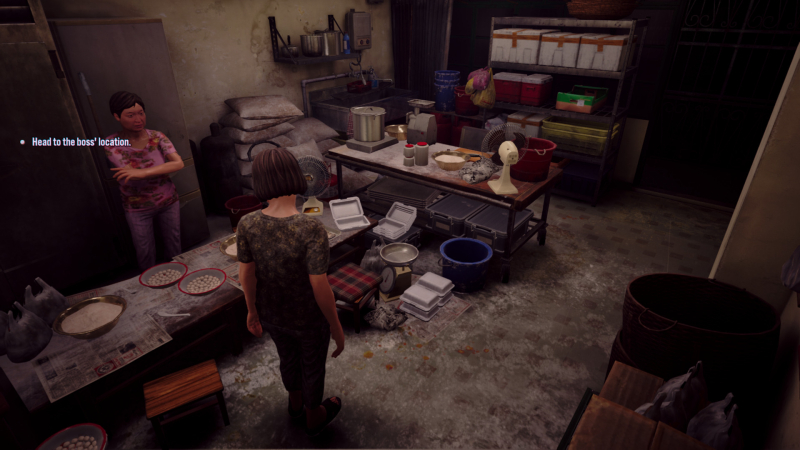
It’s enough to look around any room and you immediately understand the conditions in which people live.
The spirit itself cannot cope with such monsters, and therefore it uses the help of other people. Slitterhead reveals its most interesting feature in the very first minutes – by controlling the spirit, we can inhabit the body of almost any person. Older players will remember Driver: San Francisco, but it’s easiest to compare the project with Watch Dogs: Legion, where they allowed you to control any passerby – be it a woman in a headscarf, a businessman in a suit, or a construction worker. It’s about the same thing here – having moved into a person, you take complete control over him and can run, jump and “jump” into other people.
Although this has already happened in other games, the idea still seems quite original – at least because in projects with a similar idea, the storylines were not the most exciting. And here they were able to come up with a fascinating and even philosophical story. The main characters (besides the spirit) are rarity people, who also hate slitterheads and are ready to kill them at any opportunity. And at some point the player wonders if they are doing the right thing, if they are becoming as bloodthirsty as those they hunt. Especially when you learn about the existence of a special shelter where slitterheads try to coexist peacefully with people. And then you meet monsters in different establishments who pretend to be people and try to become a valuable part of society without transforming or devouring anyone.
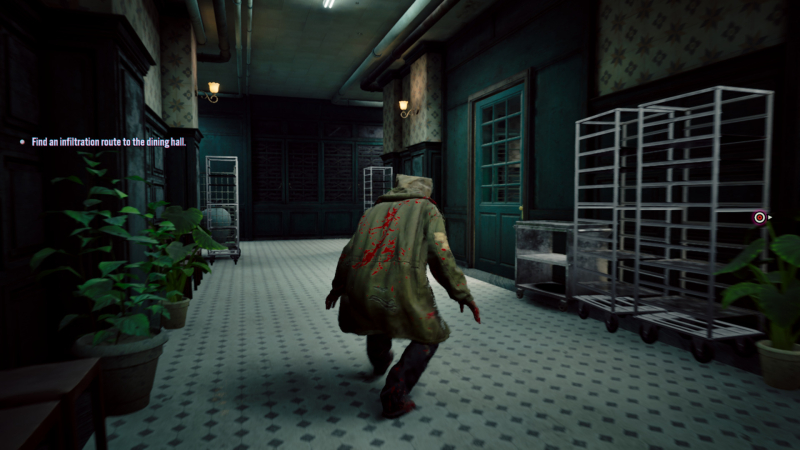
There are a lot of stealth episodes in the story missions, but they, surprisingly, are not annoying – also because you can temporarily fly out of your body and explore the surroundings
⇡#Blood, murders, but no swearing
At the same time, the gameplay of Slitterhead is not nearly as serious as the story. The gameplay is reminiscent of either a simplified Devil May Cry or Prototype – be that as it may, the combat system is very unusual for a horror game from Toyama. Before the start of the mission, you choose the main rarity and his assistant – you will start the passage as the first one, and you can switch to the other during research or combat. However, of course, you won’t have to control only these two – at any moment you can inhabit someone, and this someone will have the skills of the main rarity. The main characters differ in their skills: one deftly parries attacks, another shoots from a shotgun, the third throws poisonous darts – all these skills will be transferred to the people you decide to control.
The entire gameplay is based on frequent switching between city residents. In quiet moments, you will jump from one body to another to get somewhere – for example, to reach the roof of a house, looking for targets one after another on the balconies. Or you will enter a locked room, where there is only one person and only a small window is open, through which your spirit will move into someone. These can hardly be called puzzles, since it is always more or less obvious what needs to be done, but the process does not get boring until the end of the game – this mechanic is so fun. There is no need to worry about leaving the bodies of rarities behind – when the battle begins, they will be nearby in a few seconds.
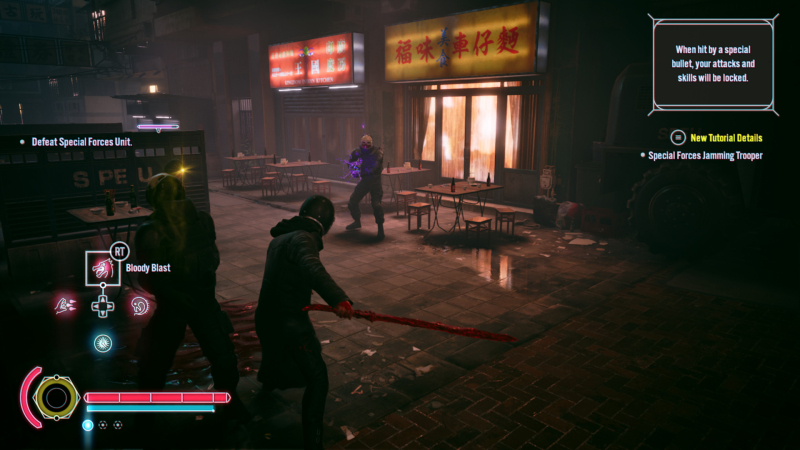
Melee weapons – durable clots of blood that appear in the hands of heroes as quickly as they disappear
In fights, it is also advisable to jump from one person to another. Although rarities have more health and unique passive skills (more on those later), they are not always the best choice. Someone can be seriously injured – for example, large opponents sometimes cut off the hands of rarities, and it takes time to recover. And some monsters impose negative effects that are removed by hitting the human shell hanging behind them – you distract attention, fly out of the body, inhabit someone behind and hit. But the main thing is that when you jump from one body to another, you increase the health reserve and attack power of the next shell. So, if you don’t want to drag out the next battle, it’s better to constantly be on the move. The sudden appearance of people in battles sometimes seems ridiculous – for example, when you fight a monster on an empty roof – but this is still a video game.
It is worth admitting that at first the “combat” seems very crooked and even ridiculous at times. There’s a target focus button, but the game doesn’t always select the opponent you want to focus on. Enemy attacks can be parried, but in terms of mechanics, Slitterhead is very different from soulslikes and other melee action games – here the opponent swings, a corresponding icon appears on the screen, and you need to move the right stick in the right direction, which is already unusual. Moreover, this should not be done immediately after the symbol appears, but after one or two seconds.
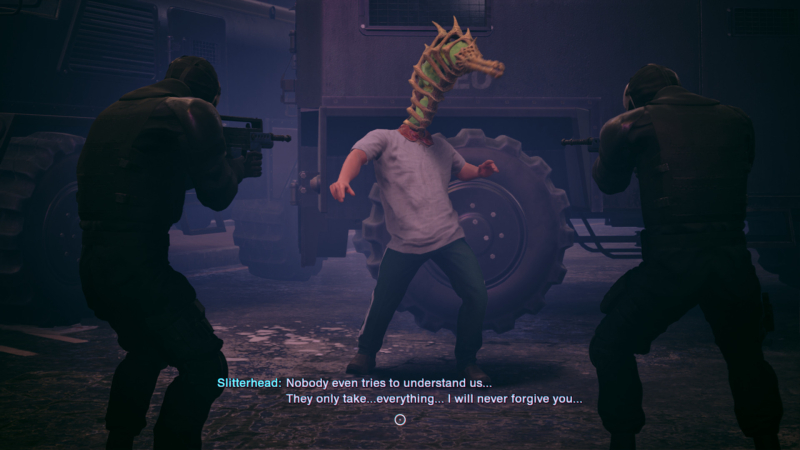
Almost no one likes Slitterheads – they have to respond with aggression
Everything changes when you start pumping up rarities. The game is very generous in giving out points to improve stats, and it’s a rare case that the skill tree actually has a lot of useful upgrades. Here you can quickly restore a severed arm using a simple QTE, and simplified parries, and small explosions when moving into other people’s bodies – some “passives” are relevant only for rarities, and some are available in every body. In any case, they make the combat system more fun, and you pay less and less attention to its curvature. Especially when you also invest in improving active abilities and either increase their range of action or increase damage.
However, just praising the gameplay does not work. The budget was clearly small (this is also indicated by the mostly unvoiced dialogue). Therefore, they came up with the idea of Hioki’s ability to return to the past – for example, to save someone. This leads to the fact that the appearance of a new mission often means a return to old locations. And with this, in turn, is connected the need to fight the same opponents. Although in this game even seemingly different bosses are similar to each other – it is difficult to understand the difference between an octopus slitterhead and a mantis slitterhead, they attack approximately the same. In addition, it is annoying to have to replay already completed missions in order to find other hidden rarities – you rarely have to do this, but it would be better if the game warned that without this the plot will not continue.
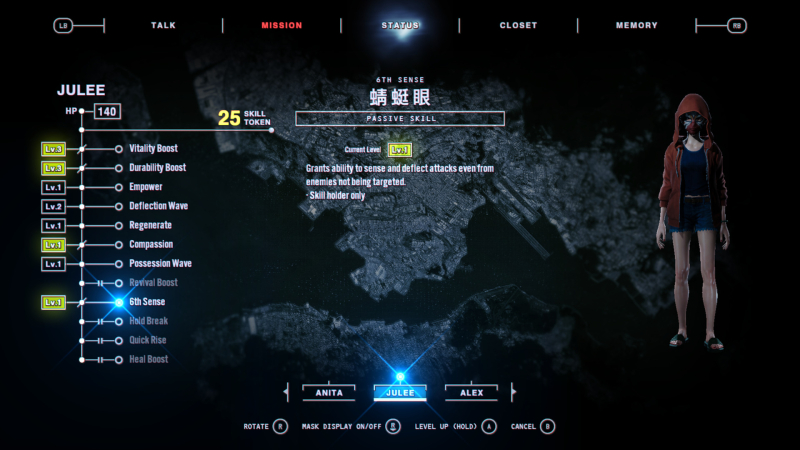
We didn’t draw beautiful skill trees – the main thing is that there are a lot of useful abilities there
However, the strangest element of the gameplay is the chases. Some slitterheads refuse to engage you in battle and prefer to run away, and at first such episodes seem funny. You chase a target, transform into other people to catch it, jump on neon signs, like in the recent battle royale in the Vampire: The Masquerade universe. You crash into passers-by, trip over boxes with which the enemy is trying to block the passages. But over time you realize that the chase will be crowned with success in any case – there is no timer, it is impossible to miss the slitterhead. There is no point in catching up and causing damage – the game itself will determine when the target gets tired of running. Sometimes you make circles two or three times, running in the same places. Japanese developers have some problems with chases in their games – I immediately remember Lost Judgment, where this mechanic was just as poor.
***
Despite its shortcomings, you still love Slitterhead – it belongs to the category of games whose shortcomings can be forgiven, since its advantages are very bright. That is, you understand with your mind that this project is not for everyone, that it looks out of date, that some elements are made so-so, but you still go through it not without pleasure. The game seems to have been developed and hidden somewhere back in the PlayStation 3 era – both in a bad and in a good way. It is outdated in places, you never quite get used to the lack of voice acting, the plot is presented strangely – through dialogues with each rarity separately in the breaks between missions. But at the same time, the game returns to the times when Japan Studio existed, which was allowed to release completely new unique projects, and not rivet endless sequels. Those who miss that period in the industry should definitely check out Slitterhead – it’s weird and different, and that’s what makes it good.
Advantages:
- Atmospheric and detailed city;
- An intriguing story with a philosophical touch;
- An unusual idea with the ability to control almost any person – the mechanics are used both in battles and beyond;
- The combat system reveals itself better as you level up;
- Excellent mystical soundtrack by the maestro of the genre.
Disadvantages:
- Monotonous opponents who become boring by the end of the game;
- Almost complete absence of voiced dialogues, crooked animations and other costs of a small budget;
- The chases for the fleeing slitterheads are sometimes very drawn out.
Graphic arts
What can we hide here? Slitterhead doesn’t look very modern. But the city turned out to be beautiful, and the virtual operator in the story videos quotes either the games of the Siren series or the films of Wong Kar-wai.
Sound
The eerie and mystical music was written by Akira Yamaoka, who tried to come up with excellent dark melodies for his old friend’s project. But you can’t really appreciate the work of the actors – they talk extremely rarely, most of the dialogues are not voiced.
Single player game
There is no open world; instead, after completing the mission, you go to the menu, where you first need to chat with all the rarities, and then select the next task on the map. Over time, I like this structure more and more, especially when the plot is interesting.
Estimated time of completion
15 o’clock.
Collective game
Not foreseen.
General impression
An action game for those who miss the extraordinary Japanese games of the PlayStation 3 era, which were mainly produced by Sony Japan Studio. An unusual idea and an intriguing plot are combined with outdated graphics and crooked gameplay – everything is exactly as it should be.
Rating: 8.0 / 10
More about grading system
Video: